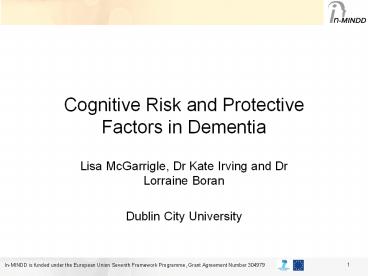Cognitive Risk and Protective Factors in Dementia - PowerPoint PPT Presentation
1 / 13
Title:
Cognitive Risk and Protective Factors in Dementia
Description:
Cognitive Risk and Protective Factors in Dementia Lisa McGarrigle, Dr Kate Irving and Dr Lorraine Boran Dublin City University * Overview Background to the study - In ... – PowerPoint PPT presentation
Number of Views:52
Avg rating:3.0/5.0
Title: Cognitive Risk and Protective Factors in Dementia
1
Cognitive Risk and Protective Factors in Dementia
- Lisa McGarrigle, Dr Kate Irving and Dr Lorraine
Boran - Dublin City University
2
Overview
- Background to the study - In MINDD (FP7 project)
- Aims
- Identify cognitive dementia risk factors
- Identify cognitive protective factors against
developing dementia - Develop and validate a model of cognitive reserve
(CR) based on risk and protective factors - Methodology Dual approach
- Meta-analyses of cognitive inactivity/activity as
risk and protective factors respectively - Development of CR model in MAAS data AND validate
CR model in DESCRIPA data
3
IN MINDD
- INnovative, Midlife INtervention for Dementia
Deterrence (INMINDD) - Measurable and
- modifiable risk factors in
- middle age have a profound impact on the risk
and/or onset of dementia in the over-70s
4
Risk and protective factors in dementia
5
INMINDD WP1 Risk Prediction Algorithm
- Aims
- Identify major modifiable risk factors for
dementia by - Systematic review of existing literature
- International Delphi expert consensus
- Develop personalised risk factor profile to
predict individual risk of developing dementia - Predict the impact of modifying the risk factors
6
Ph D WP1 - Cognitive Risk Factors
- To date, 1st Delphi round has been conducted
(INMINDD) - Finding Low cognitive activity ranked as a
modifiable risk factor in cognitive decline -gt
relative risk (RR) of low cognitive activity
remains unknown - AIM Conduct meta-analyses of cognitive
inactivity/activity as risk and protective
factors respectively
7
Methodology
- Dual approach Meta-analyses (part 1) and
validation of risk and protective model (part 2) - Overview
8
Part 2 Protection - A model of CR
- Models of cognitive reserve have proved wanting
because of the lack of evidence to address the
issue of construct validity - Satz et al. (2011) propose a four-factor
conceptual model of reserve that is - (a) derived from the current extant literature
- (b) empirically testable
9
4-Factor Model
Cognitive Reserve
10
Testing CR Model - MAAS data set
- The model will be developed on a large dataset of
risk factors and cognitive decline/dementia
outcomes Maastricht Ageing Study (MAAS) - 12-year follow-up study on cognitive ageing
(N1800, baseline) - Model validation using DESCRIPA (N880)
11
Testing CR Model
- Proposed analyses
- Exploratory factor analysis
- to determine what groupings of indicators most
effectively predicts variance observed in
conversion to dementia - Hypothesis testing of the model using
confirmatory factor analysis or SEM - to further elucidate the underlying structure of,
and the relationships among, hypothesised
constructs
12
Next Steps
- INMINDD has identified low cognitive activity as
a major modifiable risk factor for dementia - This study aims to conduct exploratory
meta-analyses of this risk factor to determine
relative risk (RR) - Meta-analyses will also be conducted to explore
protective effects of cognitive activity - A model of cognitive reserve will be empirically
tested to determine construct validity
13
THANK YOU!Contact lisa.mcgarrigle5_at_mail.dcu.ie































